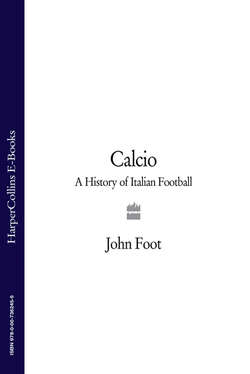Читать книгу Calcio: A History of Italian Football - John Foot - Страница 29
The inauguration which changed Italy
ОглавлениеFor Italy, 1926 was a key year, as Benito Mussolini was anxious to move the country further towards a fascist dictatorship. The spark which led to the final destruction of the country’s fragile democracy was linked to football. Arpinati had ordered the construction of a spanking new stadium in Bologna in 1924 and by the end of October 1926 the ground was ready for an official inauguration, to coincide with the fourth anniversary of the March on Rome. Mussolini came to Bologna for the occasion, and entered the stadium on a white horse to huge applause. After making a speech and opening a fascist foundation, Mussolini was driven to the station by Arpinati himself, in an open limo known as a ‘torpedo’. As the dictator passed through the crowds, a gunshot was fired into the car, missing everyone and, allegedly, passing through Mussolini’s scarf. In the chaos that ensued, a fifteen-year-old boy was beaten to death by the crowd and identified as the potential assassin. The boy, Anteo Zamboni, was the son of a well-known local exanarchist. The whole Zamboni family was sent into internal exile for having organized the supposed attempt on the Duce’s life. Years later, a plaque was unveiled where Zamboni had been killed.37
There are strong doubts about the role of Zamboni, and many historians claim that the shot was the work of dissident fascists or even the Italian secret services.38 Arpinati, to his credit, pressed for an amnesty for the family – he was a friend of the boy’s father. Meanwhile, the consequences for Italy of Mussolini’s trip to Bologna for the new stadium were dramatic. In November 1926 new laws were passed reintroducing the death penalty that had been abolished in 1888. All political parties apart from the Fascist Party were banned along with their newspapers and a special fascist secret police service was set up. The last vestiges of free speech and democracy had been removed.
